| Biodiversity and its Conservation Refresher Course |
| Biodiversity and its Conservation Concepts Files |
| Biodiversity and its Conservation Master Files |
| Biodiversity and its Conservation Revision Note |
| Biodiversity and its Conservation Note 1 |
| Biodiversity and its Conservation Note 2 |
| Biodiversity and its Conservation Reference Book |
Biodiversity and Conservation
Table of Content
- What is Biodiversity?
- Types of biodiversity portrayed by Edward Wilson
- Pattern of Biodiversity
- Loss of Biodiversity
- Biodiversity Conservation
- Frequently Asked Questions
What is Biodiversity?
Biodiversity: the term biodiversity alludes to the species, a totality of genes, and biological systems or ecosystems of a locale.
Types of biodiversity portrayed by Edward Wilson
Genetic Diversity
A solitary species may indicate high diversity at the hereditary level over its distributional range.
- Medicinal plant Rauwolfia vomitoria of Himalayan range produces dynamic compound reserpine indicates hereditary variation
- India has more than 50000 diverse strain of rice
- 1000 assortments of mango
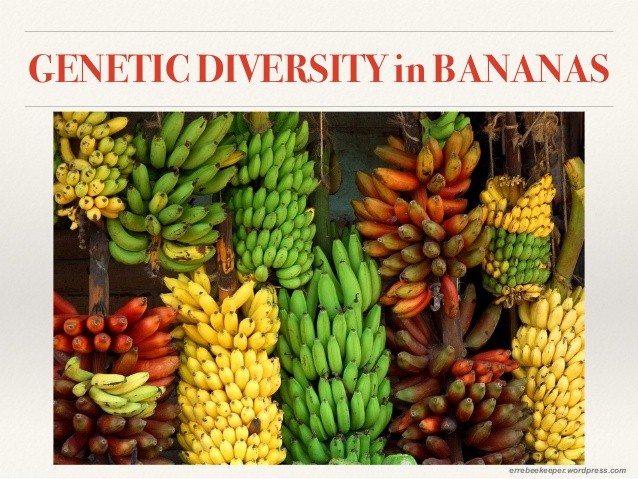
Fig: Genetic Diversity in Bananas
Species Diversity
- Distinctive species of a solitary creature like the frog

Fig: Five species of coexisting Barblers
Ecological Diversity
- Diversity in the biological community level like mangroves, rainforest, coral reef, desert, wetlands, estuaries and so on.
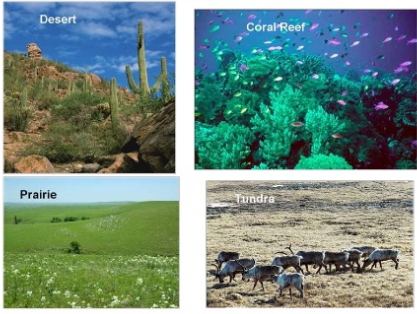
Fig: Ecosystem Diversity
How many species are there on Earth and How many in India?
- According to IUCN (2004), 1.5 million of plants and creatures are in our biosphere.
- Robert May places worldwide species diversity at around 7 million.
- More than 70 percent of the considerable numbers of species that are recorded are found to be animals.
- All plants compose approximately 22 percent.
- Among creatures, insects compose 70 percent.
- India has just 2.4 percent of the world’s territory zone; its share of worldwide species diversity is amazing 8.1 percent.
- India is viewed as one of the mega diversity nations of the world.
Pattern of Biodiversity
Latitudinal Gradients
- Species diversity diminishes as we move towards the pole far from the equator
- Tropic (23.5o N to 23.5o S) consists a larger number of species than pole and temperate
- The generally tropical Amazonian rain woods in South America has the best biodiversity on earth:
- 40,000 species of plants
- 1300 of birds
- 3000 species of fishes
- 378 reptiles
- 427 amphibians
- More than 1, 25,000 spineless creatures
Why tropical rain forest has greater biodiversity
- Unlike temperate districts subjected to continuous glaciations previously, tropical regions have remained moderately undisturbed for a large number of years and along these lines, had a long trans-formative time for species enhancement.
- Tropical environments: On contrary like temperate ones, tropical environment are less common, generally more steady and unsurprising, advances niche specialization and prompt to more noteworthy species diversity.
- There is more solar energy accessible in the tropics, which add to higher efficiency.
Species area relationship:
- Alexander Von Humboldt saw inside a district, species richness expanded with expanding investigated region yet only till a particular limit.
- The connection between species richness and region for a wide assortment of taxa ends up being a rectangular hyperbola.
- On a logarithmic scale the relationship is a straight line portrayed by the equation
LogS = logC +Z log A
Where, S= species richness, Z = incline of the line (relapse coefficient), A = Area, C = Y-intercept.
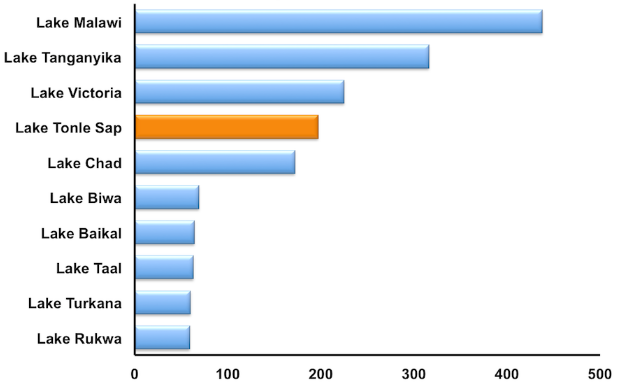
Fig: Fish Species Richness
- It has been noticed that no matter what, taxonomic group or district, the incline of the regression line are incredibly comparable. Be that as it may, for a substantial territory like the whole continent the slant of the line is more extreme.
Importance of species diversity to the Ecosystem
- Community consisting of more species by and large has a tendency to be more steady than those with fewer species.
- A stable group ought not to demonstrate a lot of variation in profitability from year to year; it must be safe or strong to natural aggravations (man-made or natural).
- Stable people group must be impervious to attack by outsider species.
Loss of Biodiversity
- The IUCN Red List (2004) reports the elimination of 784 species.
- Recent annihilation incorporates:
- Dodo (Mauritius)
- Thylacine (Australia)
- Three subspecies of tiger (Bali, Java, Caspian)
- Quake (Africa)
- Stiller’s dairy animals (Russia)
- Since the root and broadening of life on earth, there were five scenes of mass eradication of species.
- The 6th mass Extinction is in advance at this point.
Ways the’ sixth Extinction’ is different from the previous five extinctions.
- The current annihilation rate is 100 to 1000 circumstances quicker.
- All others are pre-human period, the current one is anthropogenic.
Effect of Biodiversity Loss
- Decrease in plant creation
- Lowered imperviousness to ecological perturbations, for example, dry season
- Increased inconstancy in certain biological community procedures, for example, plant profitability, disease and pest cycle, and water use
Causes of Biodiversity Loss
- The present loss is all because of human action (anthropogenic)
- There are four noteworthy causes “The Evil Quartet” are as per the following:

Fig: Causes of Biodiversity Loss
Habitat loss and fragmentation:
- Most essential cause driving animals and plants to get terminated.
- The tropical rain rainforest decreased from 14 % to 6 % of earth land surface.
- The Amazonian rain wood is called as ‘lungs of the planet ‘is being cut cleared for developing soya beans.
- Degradation of numerous natural surroundings by pollution likewise debilitates the loss of diversity.
- Large ranges are broken into fantasies likewise the reason for the loss of diversity..
Over-exploitation:
- When “require” swings to “voracity” it prompts to over-abuse of common assets.
- Many species eliminations in the most recent 500 years (Stiller’s dairy animals, traveler pigeons) were due to over-use.
- Many marine fish populations around the globe are over collected.
Alien species invasion:
- The outsider species or the alien species cause the decay or elimination of indigenous species.
- Nile perch brought into Lake Victoria in east Africa prompted to the annihilation of 200 species of cichlid fish in the lake.
- Parthenium (carrot grass), Lantana, and water hyacinth (Eichhornia) represented a string to indigenous species.
- African feline fish Clariasgariepinus for aquaculture purposed is representing a risk to indigenous catfishes in our waterways.
Co-extinction:
- When a species gets to be distinctly terminated, the plant and creature species connected with it in a compulsory way additionally get to be distinctly wiped out.
- Extinction of Host species prompts to termination of the parasite moreover.
- Co-advanced plant-pollinator mutualism where eradication of one perpetually prompt to the termination of the other.
Biodiversity Conservation
Why should we conserve Biodiversity?
Reason for biodiversityconservation is grouped into the following three categories.
- Narrowly utilitarian
- Broadly utilitarian
Narrowly Utilitarian
- Humans take innumerable direct financial advantages from nature-
- Food (oats, beats, organic products), fiber, firewood, developmental material.
- Industrial items (tannins, greases, colors, tars, fragrances)
- Products of therapeutic significance.
- Bioprospecting: investigating molecular hereditary and species-level diversity for results of monetary significance.
Broadly Utilitarian
- Amazonian woods along deliver 20% of oxygen amid photosynthesis
- Pollinator layer: bumble bees, honey bees, birds and bat that fertilize the plant without which seed can’t be created by plants
- Aesthetic delight we get from the biodiversity
How do we conserve Biodiversity?
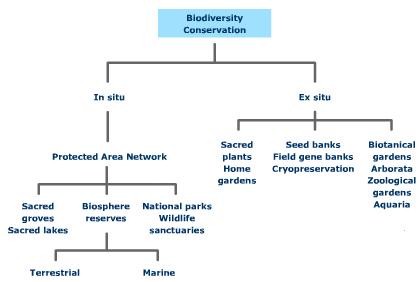
Fig. a: Scheme showing Biodiversity Conservation Management Systems
In situ conservation:
- When we monitor and ensure the entire biological community, its biodiversity at all level is secured – we spare the whole timberland to spare the tiger. This approach is brought in situ (on location) protection.
- Biodiversity hot spot: areas with large amounts of species richness and high level of endemism.(species bound to that locale and not discovered anyplace else)

Fig. b: Endemism in India’s Biodiversity
- Hot spot in biodiversity is additionally areas of quickened habitat loss.
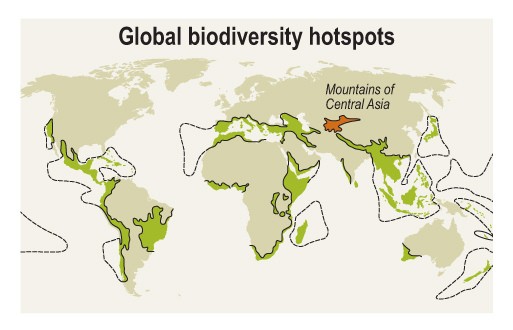
Fig. c: Global Biodiversity Hotspots in the World
- Out of 34 problem area on the planet, three hot spot situated in India are:
- Western Ghats and Srilanka
- Himalaya
- Indo-Burma
- Other ensured region under in situ preservations are:
- 14 biosphere reserve
- 448 wild life sanctuary
- 90 national parks
- Sacred forests: tract of woodland were put aside, and every one of the trees and untamed life inside were loved and given aggregate security.
Ex situ conservation: debilitated plants and animals are taken out from their regular living space (natural habitat) and put in an uncommon specialized setting where they can be ensured, protected and given extraordinary care.
- Zoological Park
- Wildlife safari
- Botanical garden
- Genetic strains are safeguarded in seed bank
- Conservation of gamete by cryopreservation
Convention on Biodiversity
- “The Earth Summit” which was held in Rio de Janeiro in 1992 called upon all countries to take suitable measures for the preservation of biodiversity and practical usage of its advantages.
- The World Summit, South Africa 2002
World Summit on Sustainable advancement took place in 2002 in Johannesburg, South Africa, where 190 nations promised their dedication to accomplish by 2010 a noteworthy lessening in the present rate of loss of biodiversity at worldwide, local and neighborhood level.
Frequently Asked Questions
Q1: Why is biodiversity valuable?
Answer: Most conservation scholars perceive that biodiversity is important in two ways:
Biodiversity has utilitarian esteem since it benefits individuals straightforwardly and keeps up connections between the living and non-living parts of nature. For instance, biodiversity has given plants to yields that nourish billions of individuals, and additionally disintegrating life forms, (for example, bacteria and fungi) that discharge supplements from natural material into soil and water.
Biodiversity likewise has characteristic esteem to many individuals. At the end of the day, it has worth past the products and enterprises it gives people and ecosystems.
Q2: What does endangered mean?
Answer: Under the 1973 Endangered Species Act, a species is recorded as jeopardized in the event that it may be “in risk of annihilation all through all or a noteworthy bit of its range.” Such species are more risked than undermined species, or those that are “probably going to wind up distinctly imperiled species inside the not so distant.” The status of a species (unlisted, debilitated, or jeopardized) can change as we take in more about it or as we actualize its recuperation plan.
Q3: Why is protecting any one species important?
Answer: There are three responses to this question. To start with, in the event that you trust that biodiversity has inborn esteem, then every species is profitable and ought to be shielded from eradication. Second, the annihilation of a solitary species may diminish the utilitarian estimation of nature. For instance, if the species has financial esteem, its annihilation unmistakably brings about a monetary misfortune.
Moreover, if the species is vital to different species or for the support of imperative ecosystem attributes, then its eradication can have undesirable falling impacts. For instance, beavers dam streams and make systems of lakes that give environment to species like fish and ducks and that enhance water quality and anticipate disintegration. The loss of beavers, in this manner, would bring about the loss of different species and also of the ecosystem administrations gave by the living space they make.
Q4: What is conservation biology?
Answer: Conservation biology is a mission-arranged science that spotlights on the best way to secure and reestablish biodiversity, or the diversity of life on Earth. Like therapeutic research, conservation biology manages issues where snappy activity is basic and the results of disappointment are extraordinary. To safeguard biodiversity, researchers must answer three general inquiries. To start with, how is the diversity of life circulated around the planet. Second, what dangers does this diversity confront. Third, what can individuals do to diminish or take out these dangers and, when conceivable, reestablish organic diversity and ecosystem health.
